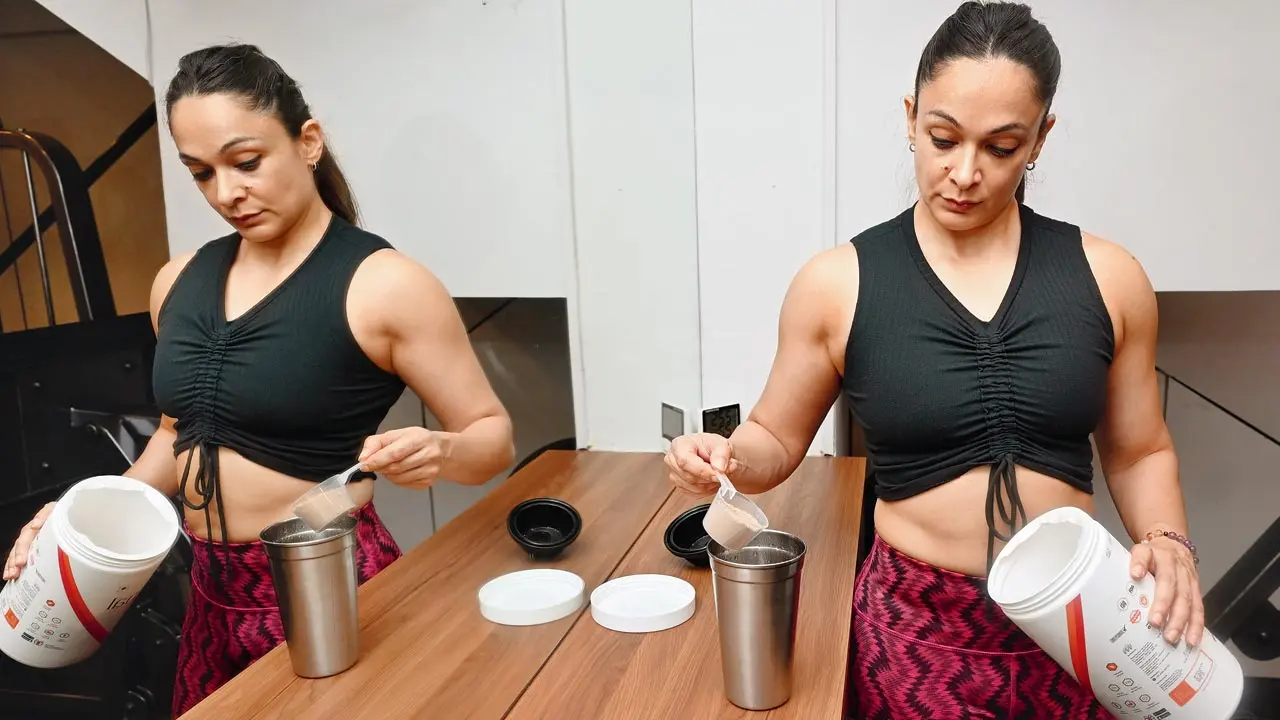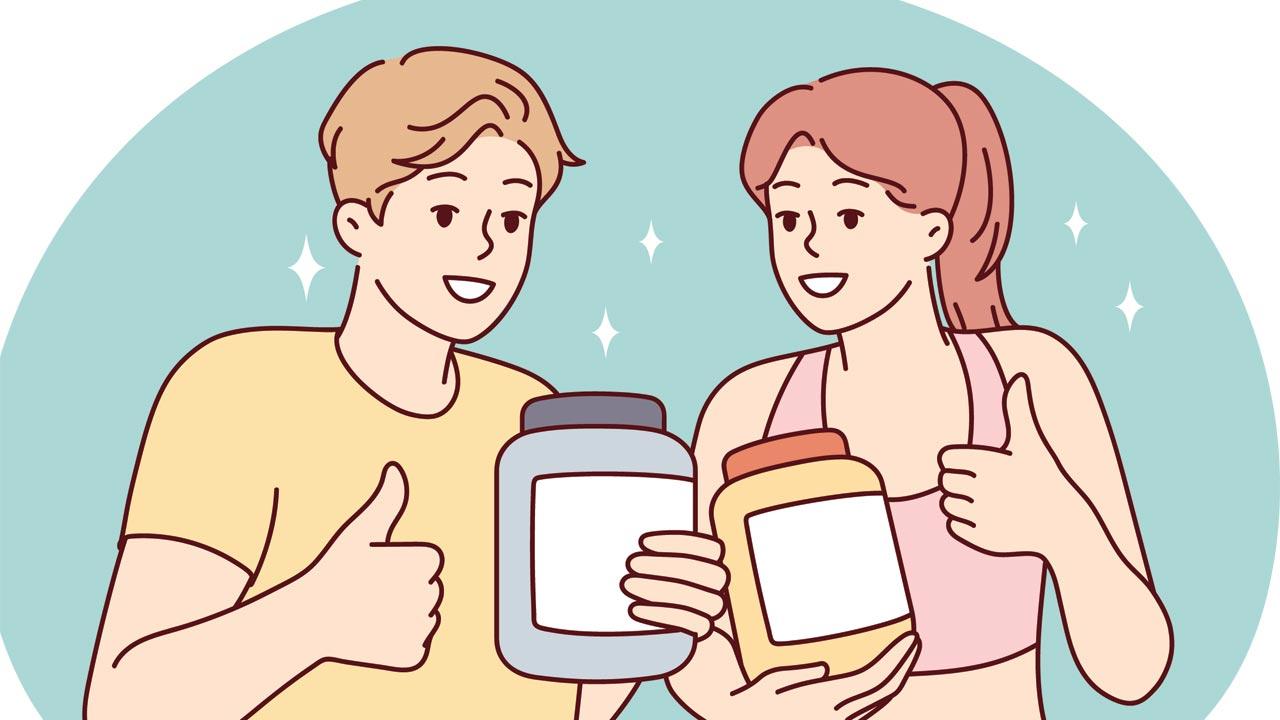Last month saw the launch of a protein kulfi by a major Indian ice cream maker, adding to a slew of similar snacks that have arrived in the market over the past year. We ask, are these really safe to eat?

Shwetha Bhatia, a registered dietican says that its important to know what is the content of the new ‘protein . Pic/Satej ShindeLocation courtesy United Strength Gym
A scoop of ice cream and bag of chips — is this you cheating on your diet, or going one step further to meet your protein quota?
Until very recently, “protein” used to be something just the gym bros talked about, bragging about how much whey powder they were packing into their smoothies. Suddenly, it’s become the new buzzword and one can spot it everywhere — in yoghurt, cookies, cereal, and even mocktails. Everyone and their mother is talking about protein and how to maximise it. But why is that?
Turns out, Indians are perennially protein-deficient. Vegetarian or non-vegetarian, it doesn’t matter. A 2018 study by global market research firm Ipsos found that 84 per cent of Indian vegetarian diets and 65 per cent of non-vegetarian diets are protein-deficient.
 Ranveer Singh has started his own protein bars, stepping into the health supplement industry
Ranveer Singh has started his own protein bars, stepping into the health supplement industry
Neither is this limited to small towns and villages. A 2017 survey by the Indian Market Research Bureau found that 73 per cent of urban rich Indians (across seven cities) are protein-deficient, and 93 per cent are unaware about their daily protein requirements.
With the post-COVID boom in health awareness, though, a lot more people are aware of the need for macronutrients such as protein and how severely most of us are lacking it. All the same, not everyone can afford the protein powders that gym bros and professional athletes swear by. And that’s why protein-boosted snacks have become popular. They’re affordable little doses of protein that go well with your evening chai or make for a post-meal dessert, like the latest launch by a major Indian dairy brand — a protein kulfi.
While there’s no “mad rush” for this new protein munchies market, say dieticians, nutritionists and wellness trainers, they all agree that they have seen a surge in clients asking about them.
 Arjun Garewal; Fiona Sampat and Kamna Desai
Arjun Garewal; Fiona Sampat and Kamna Desai
“There are two categories of people who are asking about it; the 20-something health-aware person, and the older working adult for whom this is a great alternative to the 5-o’-clock munchies,” says Fiona Sampat a clinical dietician at Kokilaben Hospital.
Although the protein snack is the better of the two evils, people must exercise caution and not overdo it, says Sampat. “I often see that people do not read what these ‘healthy snacks’ comprise. It may be better than the generic potato chips, but it happens to be loaded with trans fats, sugars, and artificial ingredients, which might negate the original purpose altogether,” she cautions.
While none of the brands have ever claimed to be free of carbs, fat, or gluten, they do promise to have these components in lower percentages than the regular version of the snack. A protein-chip company, for example, does claim its chips have lower fat percentage than regular chips.
Shwetha Bhatia, a registered dietician with a penchant for training hard in the gym, has a little more faith in the common man, especially with the fitness revolution India has seen since the pandemic. “You do not want to undo the work you put in at the gym because you didn’t read the label right. Right now, there are very few people who go for chips or ice cream to get their protein. Post-COVID, there is acute consumer awareness and people read packaging labels and also consult experts like me,” says Bhatia.
“But yes, there’s also an appeal to such snacks. If you do want to indulge in a packet of chips, eating one with more protein would be better, as long as you understand that it may still come with other unhealthy ingredients. The price point seems to be the biggest deterrent — these chips are expensive, so they’re not replacements for food protein and protein supplements,” she adds.
For example a 37 g packet of protein chips costs anything between R40 to 50, while our favourite cream-and-onion potato chips (48 g) comes at the grand price of Rs 20.
It started with protein paneer, ushering in an era of protein snacks, says trainer Arjun Garewal. “Brands have been smart and taken advantage of the fact that today’s Indian is more protein-conscious than ever before. I feel some brands, though, are basically selling confectionery with low-quality protein as healthy snacks. A chocolate bar with added protein is not healthy,” he says.
The average “healthy snacker” does not have a balanced diet in general, he says. “On average, your diet should be around 80 to 85 per cent healthy, the rest comprise indulgences, but usually we see that it’s the other way around. And for non-gym-goers, the protein snacks will have zero advantage,” he adds.
For those among Garewal’s clientele who are really insistent, he does recommend a few options. “There are some brands that are actually good, even the ones that make ice cream. They might have an artificial sweetener — which is a whole other argument — but anything is better than sugar. I think it’s important to know which brand is just adding protein to sugar and selling it,” he adds.
Senior dietician Kamna Desai has seen over 23 years of fad diets over the course of her career and says it all boils down to one thing: ultra processed food. “High-protein chips or ice cream may appear as tempting and convenient options to reach daily protein requirements. But they fall under the ultra-processed foods category, which often contain a long list of additives [like colours, flavours, artificial sweeteners, and preservatives] along with abnormally high levels of added sugars, salt and unhealthy fats. Ultra-processed foods are definitely not healthy,” says Desai.
She also believes that the hard-to-resist nature of junk food is something that the consumer should always have at the back of their mind. “They may not offer any significant nutritional benefits beyond just a few extra grams of protein, but that comes along with loads of unwanted chemicals. It’s critically important for consumers to read the labels on such foods and understand the pros and cons. Chips and ice cream can be easily over consumed, leading to excess calories and potential negative health effects. It’s important to consider these new tech foods within the context of a balanced diet rather than going overboard with their consumption,” she adds.
TL;DR? Yes, your worst nightmare is true: You cannot gorge on chips and skip the treadmill.
‘Pricey but handy’
 Balram Vishwakarma
Balram Vishwakarma
Balram Vishwakarma, Co-Founder of digital marketing agency Scroll Back Studios , says, “I have this ritual of what protein I will focus on this week. It started as an experiment a few months ago, but when I began posting online people would ask me ‘what next’ and so it took on a life of its own. I have had protein powders, buttermilk, and loved one brand’s blueberry shake. I think these protein-on-the-go snacks are great because its better to binge on that instead of something harmful. The only pain seems to be the price point, but when it’s a busy day these protein foods come in extremely handy.”
How much protein do we really need?
 For men: 0.8 grams per kilogram of body weight. 56 grams of protein per day; (right) For women: 0.8 grams per kilogram of body weight, or 0.36 grams per pound. approximately 46 grams of protein per day
For men: 0.8 grams per kilogram of body weight. 56 grams of protein per day; (right) For women: 0.8 grams per kilogram of body weight, or 0.36 grams per pound. approximately 46 grams of protein per day
84%
of Indian vegetarians are protein-deficient
65%
of Indian non-vegetarians are protein-deficient
90%
of Indians are unaware of the daily requirement of protein
*Sources: Ipsos and Indian Market Research Bureau
 Subscribe today by clicking the link and stay updated with the latest news!" Click here!
Subscribe today by clicking the link and stay updated with the latest news!" Click here!










